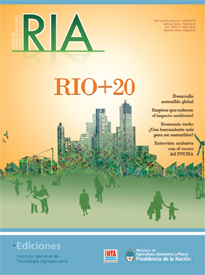Ver ítem
- xmlui.general.dspace_homeDirección Nacional y DNAsSistemas de Información, Comunicación y CalidadGerencia de Comunicación e Imagen InstitucionalArtículos científicosxmlui.ArtifactBrowser.ItemViewer.trail
- Inicio
- Dirección Nacional y DNAs
- Sistemas de Información, Comunicación y Calidad
- Gerencia de Comunicación e Imagen Institucional
- Artículos científicos
- Ver ítem
Variación estacional de los Thripidae en los montes de cerezo y la vegetación asociada al cultivo en el Valle Inferior del Río Chubut, Argentina
Resumen
En numerosas ocasiones, la flora local ofrecería a los trips el refugio, el alimento y los sitios de reproducción necesarios hasta la floración del cerezo. En este trabajo se analizó la variación estacional en los Thripidae en la vegetación asociada a montes de cerezo en el Valle Inferior del Río Chubut (VIRCh). Entre marzo de 2009 y 2010 se relevaron 2 chacras en Gaiman, con las variedades Bing, Lapins, New Star, Sunburst y Stella. Se relevaron 13
[ver mas...]
En numerosas ocasiones, la flora local ofrecería a los trips el refugio, el alimento y los sitios de reproducción necesarios hasta la floración del cerezo. En este trabajo se analizó la variación estacional en los Thripidae en la vegetación asociada a montes de cerezo en el Valle Inferior del Río Chubut (VIRCh). Entre marzo de 2009 y 2010 se relevaron 2 chacras en Gaiman, con las variedades Bing, Lapins, New Star, Sunburst y Stella. Se relevaron 13 especies de malezas (n=20 flores) y la máxima densidad de trips se obtuvo durante la floración y fructificación del cerezo. De los 15.398 individuos capturados, 76% fueron adultos y correspondieron a:
Frankliniella occidentalis (73,4%), Thrips tabaci (24,5%) y Frankliniella australis. La mayor captura de trips fue registrada en Sisymbrium irio, Medicago sativa, Brassica nigra, Cardaria draba, Cichorium intybus, Taraxacum officinale y Cirsium vulgare. En el cultivo se colectaron en total 3.000 flores y 1.500 frutos, provenientes de 2 estratos verticales. En las flores fueron obtenidos 2.104 individuos: F. occidentalis (74%), T. tabaci (24%) y F. australis. La densidad de trips fue analizada por ANOVA y Tukey en un modelo Anidado (Chacra>Variedades), que resultó significativamente diferente entre las variedades. Del muestreo de frutos fueron obtenidos 76 individuos (todos adultos), correspondientes a: F. occidentalis (90%) y T. tabaci. El daño, valorado mediante una escala cuali-cuantitativa, fue analizado por Tablas de Contingencia (chacra/variedad/nivel de daño). El daño acumulado fue significativamente diferente entre variedades: 77% Lapins, 62% Stella, 48% Newstar, 32% Bing y 25% Sunburst; produciendo pérdidas económicas. Las malezas hospedantes sustentaron e incrementaron a las poblaciones de trips, por lo que se sugiere orientar las medidas de manejo hacia determinadas especies que actuaron como los reservorios más importantes, así como avanzar y profundizar en los estudios sobre las diferencias entre variedades.
[Cerrar]
Local weeds might offer refuge, nutrition, and breeding sites to thrips until the cherry blossom initiates. We analyzed season appearance of Thripidae in flowers of weeds growing around cherry orchards in VIRCh. From March 2009 to 2010, there were sampled 2 farms in Gaiman, with varieties Bing, Lapins, New Star, Sunburst y Stella. There were collected 20 flowers of thirteen Dicotyledonous weeds, and from 15,398 thrips caught, 76% were adults and species
[ver mas...]
Local weeds might offer refuge, nutrition, and breeding sites to thrips until the cherry blossom initiates. We analyzed season appearance of Thripidae in flowers of weeds growing around cherry orchards in VIRCh. From March 2009 to 2010, there were sampled 2 farms in Gaiman, with varieties Bing, Lapins, New Star, Sunburst y Stella. There were collected 20 flowers of thirteen Dicotyledonous weeds, and from 15,398 thrips caught, 76% were adults and species were Frankliniella occidentalis (73.4%), Thrips tabaci (24.5%), and Frankliniella
australis. Their highest density overlapped with berry blossom and fruits. The most were found in Sisymbrium irio, Medicago sativa, Brassica nigra, Cardaria draba, Cichorium intybus, Taraxacum officinale and Cirsium vulgare. For cherry sampling, there were collected also flowers and fruits in two vertical strata. From 3,000 cherry flowers, there were caught 2,104 thrips: F. occidentalis (74%), T. tabaci (24%) and F. australis. Thrips density were analyzed by means of ANOVA and Tukey in a nested model (Farm>Variety). Thrips density was significantly different between varieties. From 1,500 cherry fruits, there were caught 76 thrips individuals and species were F. occidentalis (90 %) and T. tabaci. Fruit damage was measured using a scale of five levels and analyzed by means of a three-way Chi-Square test (farm/variety/damage level). Accumulated damage was significantly different between varieties and the top values by varieties were 77% Lapins, 62% Stella, 48% Newstar, 32% Bing, and 25% Sunburst. Then thrips caused economic loses. Weeds supported and breeds thrips populations, then we suggest keeping thrips population in weeds as low as possible, by early measures focused to certain species, which seems to act as the most important weed sources for thrips, and to carry out more studies related to differences between cherry varieties and thrips damage.
[Cerrar]

Autor
Rodriguez, J.;
Neira, Patricia;
Carrizo, Paola;
Fuente
RIA 38 (1) : 46-54 (abril 2012)
Fecha
2012-04
Editorial
Gerencia de Comunicación e Imagen Institucional, DNA SICC, INTA
ISSN
0325-8718
1669-2314
1669-2314
Formato
pdf
Tipo de documento
artículo
Palabras Claves
Derechos de acceso
Abierto
 Excepto donde se diga explicitamente, este item se publica bajo la siguiente descripción: Creative Commons Attribution-NonCommercial-ShareAlike 2.5 Unported (CC BY-NC-SA 2.5)
Excepto donde se diga explicitamente, este item se publica bajo la siguiente descripción: Creative Commons Attribution-NonCommercial-ShareAlike 2.5 Unported (CC BY-NC-SA 2.5)


